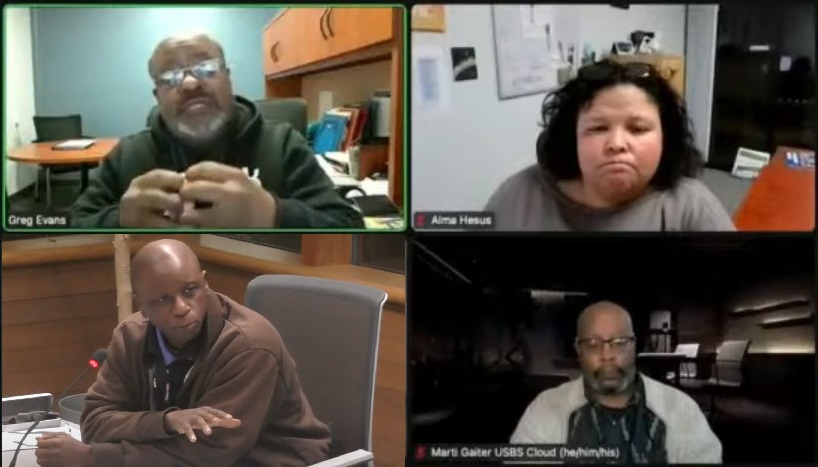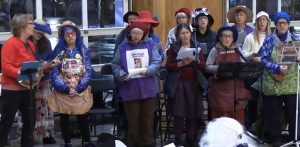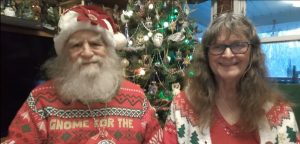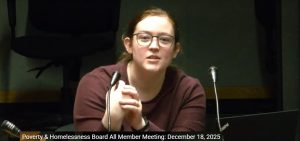Greg Evans: Rethink LTD hub-and-spoke system for cross-town service
15 min read
At Lane Transit District’s Strategic Planning Committee Nov. 28: Greg Evans says it’s time to change the hub-and-spoke system and start offering cross-town service.
Jameson Auten (CEO, Lane Transit District): I’ve had quite a bit of conversation over the last year around: ‘What do our communities need LTD to be?’ And the first part of answering that question is: What are we allowed to be, right? What are we allowed to be by statute?
[00:00:24] So we’ve taken a look and we continue to look at our enabling legislation, Oregon Revised Statute 267, and we found that, you know, we are (surprisingly) a mass transit district, right? Big surprise there.
[00:00:38] But that term ‘mass transit’ is rather broad, so our interpretation is that anything that we’re providing—fixed route services or RideSource services or maintaining properties, facilities and improvements, that’s part of the mass transit district and mass transit services, which lends itself to a mobility approach in light of the type of work we do with RideSource already. So that’s (1.)
[00:01:04] (2.) We are also able to participate in transit-oriented development, and I know that’s been some conversation whether that is the right thing to do or not, but we are able to do that. And my favorite thing that we found in here was, we’re able to build bridges over navigable streams. And I think it’d be cool to build a bridge someday, but we’re able to do that. These are the powers enumerated to LTD.
[00:01:30] We feel that the law right now as we’re defined, it’s pretty broad and lends itself to being able to address the different services that our different communities would most likely need. For instance, microtransit right down at Cottage Grove today.
[00:01:47] This is broad enough to cover how that existed 50 years ago. So I think the legislators who wrote this did a good job. We’re going to keep assessing it to make sure that we’re within the boundaries of it.
[00:01:58] So we have some pretty broad areas that we can work in. We’re assessing this for gray areas and hard stops. So we’ll continue to take a look at what this means and really, I’d like to gather your feedback on whether you think that’s politically a good thing to do.
[00:02:14] John Q: With an overview of LTD planning projects, Mobility Planning and Policy Director Tom Schwetz.
[00:02:18] Tom Schwetz (LTD): So we’ve started the Community Outreach Communications Assessment project. On Dec. 12, we’ll have the final meeting, and if you haven’t seen what’s been going on there, it’s really been constructive. I’m really impressed with that group coming together,
[00:02:34] We’ve started the comprehensive operations analysis. We have a group called Nelson Nygaard doing that work with us. And one of the things that is exciting, working with Rob’s group actually, to conduct, Nelson Nygaard’s going to conduct a downtown Eugene circulation plan and basically look at how all the different modes are going to flow in and out of downtown. We’re particularly interested in seeing that our buses are able to get in and out of that regional hub.
[00:03:04] You’re familiar with RideSource, it’s a service we’ve been operating. We’ve got a lot of innovations around that have come out of that service and the way we’re doing it. But we’ve never really taken a comprehensive look at it. So we’re taking a step back: What are we doing right? What can we improve on? That process will help us develop our work plans moving forward for that operation.
[00:03:24] And again, if you think about that service and what we do with that service, we’re already doing mobility management in that context. We’re doing a lot of work internally, we’re doing a lot of work externally, talking to community leaders, and others around this approach of being mobility managers, as opposed to just transit and fixed-route transit operators.
[00:03:47] The final project is the long-range mobility plan. The intent is that that would incorporate all the work that we’ve done here before and create those long-term goals, policies, and objectives that you want to have as a mobility manager.
[00:04:03] The mobility management framework is what I call ‘the ring that binds them all.’
[00:04:09] SPC Member: Well, I was going to say: Are you Sauron?
[00:04:16] Jameson Auten (CEO, Lane Transit District): So what we’re trying to do here is determine how do we move from our current state to really being in a position to help coordinate mobility options, transportation options that our customers readily understand.
[00:04:31] So right now, if I walk through the different services that are here today, we have our LTD suite, which includes RideSource, EmX, and fixed route. And then there’s Bike Share that’s here, there’s scooters that are here, there’s LinkLane, there’s Rhody Express or Diamond Express or there’s—for a region our size, there’s a lot of brand names.
[00:04:52] So, what we’re after is what is the best way to not necessarily operate all of those—this is not a power grab, this is not that—but to make sure that each of those services are easily understood and accessed by the consumer, whether that is a co-brand kind of situation or a rebrand or a unified fare structure with cost-sharing on the back end.
[00:05:20] Claire Syrett (SPC member): Thank you for that. On having the authority or permission to engage in transit-oriented planning: I think it would be a great tragedy if you weren’t a robust part of those conversations, right? That would be a vital missing element. So you said there was some controversy around that. From my perspective it’s absolutely a must that the transit agency be involved in that kind of work, ‘cause otherwise that work gets down a path that then may collide with the things the transit agency wants to do or is allowed to do.
[00:06:01] Rob Zako (Executive director, BEST): Thank you for that, Jameson. I think that what the community needs is a larger question and a more fundamental question that we need to understand: What are the community’s transportation needs? And then there’s questions about who provides it, how, with what funding, with what regulatory authority, with what technology. There are lots of real-world obstacles and barriers there to overcome.
[00:06:25] Greg Evans (Eugene City Council): I’ve been in this community for 37 years and on the LTD board for seven and saw the implementation of EmX from Franklin Boulevard through West Eugene.
[00:06:38] We’re talking about what our community needs, but we also need to talk about what our community wants. And wants are an incredible driver when we talk about access to different forms of transportation, and do these models take people to where they want to and need to go.
[00:07:01] And so I’m going to go back to the whole idea of looking at reforming the current system, the hub-and-spoke system that we have now, and looking at a more integrated system that would provide cross-town and cross-community routing for the fixed-route service as well as on-demand service that will help, microservice that will help further outreaching areas of our community.
[00:07:35] So I represent West Eugene / Northwest Eugene, and we’re continually grappling with the issues of being underserved in terms of transportation options that extend further than the single occupancy vehicle that most of us are contending with in Northwest Eugene every day.
[00:08:00] This is why Barger, Royal, Roosevelt are continually clogged and we don’t have a workable solution to those transportation snarls as well as being able to get people where they want to go in a timely manner—it doesn’t take you one or two bus changes to get from one side of town to the other.
[00:08:28] So with the downscaling of hospital services in West Eugene, and that Urgent Care in West Eugene moved over to Hilyard, if you need to go to (PeaceHealth Sacred Heart Medical Center at) RiverBend, how do we get to RiverBend vis a vis the existing system that we have? But how do we augment that system to be able to improve the access and the transportation options that people have, to getting from West Eugene to RiverBend?
[00:08:59] And so we have holes in service across the region that are impacted by a lack of service in the transportation sector, meeting the needs and the wants of where people want to go…
[00:09:14] We are operating on a system that structurally was the same system that was built and created in 1970. Operationally, that’s what we’re working with. And so the community, from my perspective, has outgrown that particular template. The hub-and-spoke template is no longer a viable template for fixed-route bus service or transportation service in general in the area.
And so we really need to rethink the points of entry that ridership has to the system and where the system is going, where people want to and need to go.
[00:10:02] We have had this opportunity for many years. We’ve talked about it ad infinitum, but we have not made a substantive move to re-imagine or change the hub-spoke system that we have, that was conceived and implemented back in 1970.
[00:10:22] Eugene and Springfield and Lane County are different places now than they were 50 years ago. And I don’t think that from a transportation planning perspective, we have responded very well to the growth and those changes in our community. And that’s the point that I’m trying to make. How can we think differently about this, given the current realities that our community is experiencing?
[00:10:54] Marti Gaiter (SPC vice chair): Thank you, Councilor Evans, for that point. It’s something we need to talk about. Let’s just pull the band-aid off. Let’s go at it…
[00:11:00] I also do live in West Eugene off of West 11th, and I will say, the main routes, the EmX, I will tell you is fantastic from West 11th all the way to RiverBend. The EmX is great for getting from one side to the other. I have been mind-blown at how easy it is for me to get from this side of town to the other side of town. I almost don’t want to get a car, because it is so easy to get to the other side of town sometimes, especially during rush hour.
[00:11:22] My biggest concern is the side routes—making sure that those are very well up-to-date and making sure people know how to access those side routes that aren’t so popular and aren’t so well traveled as the EmX. I think that is something we should be thinking about, that side route piece, because I think that’s sometimes something that is overlooked. Like: Where do these these routes go? Are these routes’ schedules up to date? Are they matching what we’re trying to do for the future? I think that’s something that is sometimes maybe missed a little bit for our communities.
[00:11:54] Tom Schwetz (LTD): Listening to what Greg talked about, very clearly fixed-route service is not solving the mobility issues and needs of that neighborhood. And that’s not the only neighborhood where that’s the case. Something like 50 percent of the population doesn’t have access to half-hour service or better in the district. That really cries for more options.
[00:12:17] Rob Zako (BEST): I confess that I have not ridden an LTD bus in a long time. For my trips, I’m finding that Bike Share is the fastest, most convenient, cheapest, and healthiest way to go. I tend to go from South Eugene to Downtown Eugene, and unlike a bus when I have to check a schedule, I can just walk a couple blocks, pick up a Bike Share bike, and go.
[00:12:41] I’m not saying that’s for everybody. I’m just making the point that different people have different kinds of trips and different sorts of needs. And it would be a mistake to assume that LTD could be all things to all people. So who and when can LTD serve well, is I think a version of the operative question here…
[00:12:56] My wife and I live in South Eugene and we share a car, and her hairdresser moved out to Santa Clara, and so we need to coordinate transportation. And she looked at the bus, and it was an hour and a half, door to door, to get from where we live to where her haircut is. The door-to-door travel time, if you take transit, is partly waiting time. If you have half an hour service, then on average you’re going to wait 15 minutes before the bus comes. If you’ve got a transfer, then there’s another wait there…
[00:13:24] And so I don’t know my wife’s trip, but there had to have been at least half an hour of waiting where the bus wasn’t moving at all, it wasn’t for the travel time. But the other part of this is travel time and traffic and local stops, so it takes longer for a bus to get from here to there than if you’re driving a car, you’re the only person there. The idea of Bus Rapid Transit was to eliminate some of the delays while you’re on the bus.
[00:13:46] Again, I don’t have the answers, but I’m wondering what’s sort of the vision out there, what we’re striving for, not that we can achieve it today, and then what steps can we take today to move in that direction?
[00:13:56] Claire Syrett: I was the executive director for a short amount of time for the Lane Coalition for Healthy Active Youth. We were working on childhood obesity prevention, and one of the ways of framing that work was: ‘Make the healthy choice the easy choice.’ So I wonder if there’s a corollary with mobility outside of the single occupancy passenger vehicle: How do we make that the easy choice?
[00:14:24] When I was serving on city council, I would hear from folks like, ‘Yeah, I’d love to take my bus, but the sidewalk ends and then I have to dangerously walk in traffic to get to the bus stop. Or fall into a pothole or fall into the mud,’ right?… I would love to get a short briefing on that Last-Mile Sidewalk Grant and what Eugene and LTD are looking at there.
[00:14:54] Vidal Francis (SPC member, Oregon Department of Transportation): This is Vidal. I’m one of those that like to think out of the box too, so I may have a couple of weird ideas that may not necessarily be great, but I just want to share them.
[00:15:05] Do look at the transportation roads or system that we do have right now, because in many respects, the service that you’re delivering is constrained by it. Some communities have gone and said, ‘You know what? Let’s just put one-way (streets) here and here simply because that helps makes the transit move much more smoothly.’ Look at our roadway systems that you have right now, and what could be adjusted or modified to help make that more doable.
[00:15:32] I also want to speak to amenities and like Rob just mentioned here, the delay or the convenience, if you will, is something that people tend to gravitate towards. But there are some opportunities that we could use in providing some sort of amenity to help folks use the system that we have right now in terms of the bus or whatnot.
[00:15:54] And one of them I already see in play and that’s with the bike racks that we do have on our buses. That in and of itself helps our riders say, ‘You know what? I can carry my bike along with me. And that doesn’t inconvenience me, because maybe I’ve got to take a longer stretch somewhere else and not have to use the bike the whole stretch.’
[00:16:14] And I believe Claire mentioned something about safety, and a lot of people, believe it or not, there’s quite a few folks, they may feel not as safe as they may want to feel and that’s something that we may want to just look at, simply because the more we increase or improve at least the sphere of safety on our buses, that will actually help those who are prevented because of that one aspect, be able to get on.
[00:16:41] The other thing I just briefly thought about, and maybe LTD is doing this already: Internet service. Again, let’s say, I’ve got to go from point A to point B, and I know that there’s going to be some delay, I know there’s going to be some lag time. Guess what? I’m going to try to bring something with me to keep me occupied or keep me utilizing that delay time such that I won’t feel it being lost.
[00:17:06] So figure out a way to use up that and this is the way I’m going to term it: ‘user inconvenient time’ or ‘lost time.’ How could we occupy that space with something that the bus service is providing us, so that that rider feels as if, ‘Okay, I’m not losing any time here, I’m actually being able to, I’m actually I have an opportunity to use up some of that time,’ if that makes sense. When you think about services like airbuses, airplanes and so forth, they know that their rider is going to sit there and wait.
[00:17:39] Jameson Auten (CEO, Lane Transit District): You just described the new Brightline railway, like, literally. They’ve taken everything of what you said and more into consideration as they put that together, from the time you walk into the station to the time you sit on the train.
[00:17:55] Rob Zako (BEST): A year ago I was in Boca Raton, Florida and the Brightline had just opened the Boca Raton station. So my wife and I took a trip from Boca Raton to West Palm Beach. And I wish I could take all of us there to experience this. It is high-speed rail. It’s nonstop from Boca Raton to West Palm Beach, which is like, 25 miles or so. It took about 25 minutes.
[00:18:16] It’s like being on a luxury airline, with going in through security checks and this sort of cadence or that experience, but it’s not up in the air, it’s on the ground on rails, and it’s got all that. But what actually blew me away is not what happened on the Brightline, but what happened once I got off.
[00:18:32] We ended up in West Palm Beach, and we had a choice of ride shuttles, bike share. There was like a complete transportation services. It didn’t just dump you out at a train station there, it fed you in the community and it’s that multimodal interconnections that actually makes that work.
[00:18:48] If somebody just built high-speed rail and said good luck with that, not a lot of people use it. But if it’s a complete transportation solution that everything connects together, that works. I don’t think we’re going to have high-speed rail in the southern Willamette Valley soon, but I think we can have that connectivity, that intermodal connectivity.
[00:19:06] And I think trying to get back to the idea of mobility management framework, I think that that’s probably what we’re talking about, of how to make those connections so that there’s a synergy that one particular mode is not going to be great by itself, but you have those connections and it becomes better.
[00:19:20] Jameson Auten (CEO, Lane Transit District): Thank you for this conversation. The things that you’re putting on the table are exactly what we’re looking to learn: What do we need, which way do we need to go?
[00:19:30] I appreciate the comments around the system design with hub-and-spoke. You know, people are using the system differently now. I wasn’t here, but I would imagine downtown is different 10 years ago than it is today. And that model needs to be updated. We have people that are working from home and just accessing the system in different ways.
[00:19:47] I think the other acknowledgement is: Transit’s hard. You really have to want to ride it, there’s these numbered names, and you have to look at the schedules, and we’re used to getting things almost instantaneously through mobile devices.
[00:20:01] Our goal is to look at how are people getting around, period, and how are the outcomes of what we do—not just ridership numbers—but how are the outcomes of what we do aligned with the desired outcomes of our communities and how do we tie into those and represent that way?
[00:20:18] John Q: With your ideas about what you want LTD to be, contact your appointed board member, listed on the LTD website.





